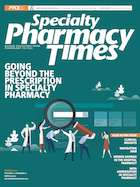Publication
Article
Specialty Pharmacy Times
Panel Discussion Highlights Evolving Hemophilia Treatment Paradigm
Experts explore current and emerging therapies for hemophilia and review best practices for management of the disease.
Hemophilia is a rare disorder in which the blood doesn’t clot normally due to insufficient blood-clotting protein or factors. Once an untreatable disease with high mortality rates, advancements in the therapeutic landscape have transformed how hemophilia is managed and have significantly improved patient outcomes.
In a recent Peer Exchange video series on specialtypharmacytimes.com, expert panelists Peter L. Salgo, MD; Lacey Chapman, RPh; Robert F. Sidonio Jr, MD; and Tim Boonstra, RPh, reviewed the historic, current, and future approaches to the management of hemophilia.
The most common types of the disease are hemophilia A with factor VIII deficiency and hemophilia B with factor IX deficiency. Hemophilia A affects approximately 1 in 5000 males, whereas hemophilia B affects 1 in 25,000. Von Willebrand disease, which is caused by a defective Von Willebrand factor, is an even more common bleeding disorder that affects 1 in 1000.
Diagnosis isn’t always straightforward and can vary, the panelists noted. At times, patients can sometimes present with life-threatening bleeding events, with more severe disease often presenting earlier in life. However, “People need to remember that those with mild disease may present when they are 10 or 15 years of age,” Dr. Sidonio said.
As patients with hemophilia are now living longer with the disease, they are more likely to experience morbidities. The panelists discussed the likelihood of joint problems as a common complication.
“People with hemophilia get blood pooling into their joints when they have a bleed, and it just compounds over time,” Chapman explained. This can lead to long-term issues, including chronic pain and a higher risk of osteoporosis. Preventing or minimizing joint bleeding events is key to reducing the risk of associated morbidities.
For many patients, hemophilia treat- ment centers (HTCs) and informed pharmacists have a crucial impact on the management of the disease. Boonstra discussed how the patient’s HTC care team comprises several health care providers who work together to optimize treatment. Describing pharmacists as the “eyes and ears for the rest of the care team,” Boonstra emphasized how the pharmacists aren’t just renewing scripts. They’re also checking in with patients, tracking adherence, and passing information along to the rest of the team.
“People who actually go to an HTC have a 40% reduced mortality rate compared with patients who don’t use an HTC,” Chapman added.
The panelists also provided a pharmacologic overview of current therapies and how the treatment landscape continues to evolve. Standard treatment with concentrated factor VIII and factor IX typically incudes 2 types: half-life products and extended half-life products. Although effective, the intravenous (IV) administration route and short half-life of these products present challenges, especially in young patients.
One of the biggest challenges in hemophilia today arises when patients develop inhibitors, or neutralizing antibodies, typically against the exogenous factor VIII.
“Unfortunately, the rate of inhibitor development has not changed,” Dr. Sidonio explained. “The prevalence in severe hemophilia A is about 13%.” He added that it typically happens in the first 20 exposures and renders therapy that worked before completely ineffective for the patient.
The emergence of emicizumab (Hemlibra) represents a potentially dramatic change in the hemophilia treatment paradigm, especially for inhibitor patients, according to the panelists. In clinical trials, emicizumab demonstrated significant reductions in bleeds compared with no prophylaxis. Further data showed a reduction in bleeds when patients were switched from factor VIII prophylaxis to emicizumab.
Emicizumab’s subcutaneous route of administration also provides an easier and more economical option for patients. In discussing the high costs of current hemophilia treatment, the panelists agreed that emicizumab has the potential to produce significant cost savings for some patients, especially those with inhibitors.
The panelists reviewed factors to consider when switching patients to treatment with emicizumab, touching on details surrounding dosing, safety, and efficacy as presented in the clinical data. Although discussion is ongoing regarding this new option, the panelists agreed that emicizumab is a game-changing therapy for most patients with hemophilia.
Looking ahead, the panel came to a consensus that novel therapeutics will continue to emerge and change the way hemophilia is managed. Innovative treatments such as gene therapy could become a reality in the near future, they noted. New subcutaneous therapies, tissue factor pathway inhibitors, and antithrombin inhibitors are also on the horizon.
“We’re really excited that there are a lot of options for patients where there weren’t,” Dr. Sidonio said.







